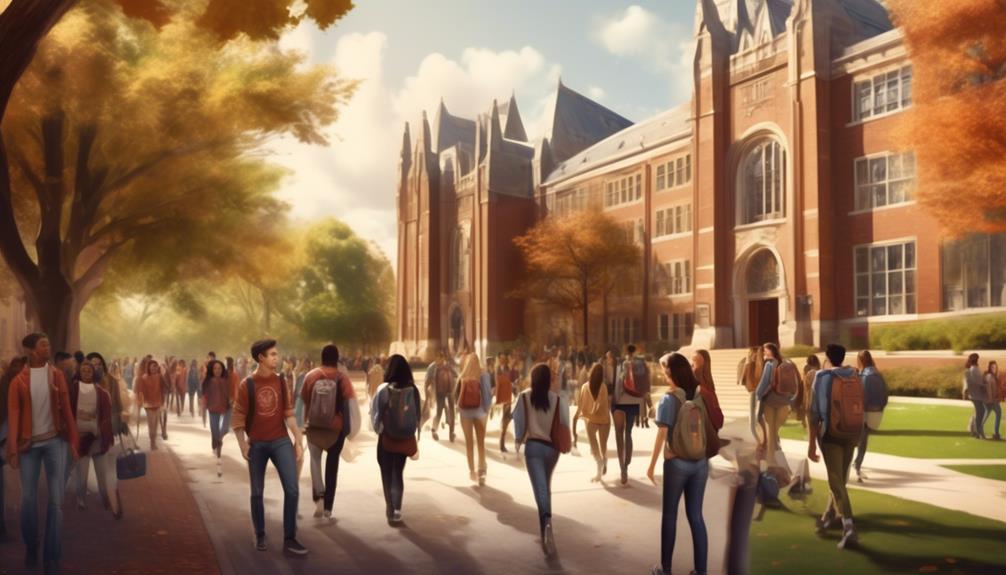In higher education, lookalike marketing presents a potent opportunity to pinpoint potential prospects with parallel predilections. The notion of using data analytics and machine learning to target individuals who mirror successful stakeholders has gained traction in recent years.
But how exactly does this method work, and what are the implications for higher education institutions? Let's explore the intricacies of lookalike marketing in the context of academia, and uncover its potential to revolutionize student acquisition strategies and optimize marketing endeavors.
Key Takeaways
- Lookalike marketing in higher education involves leveraging data to identify and target new audiences who share characteristics with the current user base.
- By utilizing digital marketing strategies and creating lookalike audiences, higher education institutions can tailor their marketing campaigns to appeal to individuals interested in programs and services.
- Lookalike audiences can be used on platforms like Facebook to effectively reach potential students and deliver tailored ads to individuals more likely to be interested in programs, leading to efficient use of marketing resources.
- The strategic use of lookalike audiences in social media marketing expands reach and engages a wider target audience, ultimately enhancing enrollment and optimizing marketing strategies for education institutions' websites.
Understanding Lookalike Marketing

Understanding lookalike marketing involves leveraging data to identify and target new audiences who share characteristics with our current user base, enabling more effective ad targeting. In the context of higher education institutions, this means utilizing digital marketing strategies to reach prospective students who exhibit similarities to our existing audience.
By creating lookalike audiences, we can tailor marketing campaigns to appeal to individuals who are likely to be interested in our programs and services. This allows us to optimize our resources and focus our efforts on those who are more inclined to engage with our website content and enrollment materials.
In the realm of education, lookalike marketing holds immense potential for higher education institutions seeking to attract prospective students. By understanding the types of audiences and their desired engagement, we can refine our marketing strategies to effectively target individuals who are more likely to enroll.
Through the use of lookalike audiences, we can enhance our enrollment marketing strategy, reaching both established and new prospects interested in our institution. This approach enables us to maximize the impact of our marketing efforts and ultimately drive higher enrollment numbers.
Application and Benefits in Higher Education
Utilizing lookalike marketing in higher education presents an opportunity to leverage data and target new audiences with characteristics similar to our current user base, ultimately leading to greater enrollment and optimized marketing strategies.
Higher education institutions can benefit from using lookalike audiences on platforms like Facebook to effectively reach potential students. By leveraging this tool, colleges can deliver tailored ads to individuals who are more likely to be interested in their programs, leading to a more efficient use of marketing resources.
Furthermore, the ability to target specific demographics within the lookalike audience ensures that ads are reaching the right people at the right time, increasing the likelihood of engagement.
When applying lookalike marketing to higher education, it's crucial to choose the right source audience and utilize high-quality data to enhance the effectiveness of these campaigns.
Ultimately, lookalike modeling allows colleges to run targeted campaigns and reach a larger audience with characteristics similar to successful stakeholders, thereby improving enrollment and optimizing marketing strategies for education institutions' websites.
Case Studies and Examples

Case studies and examples showcase the practical application of lookalike marketing in higher education, illustrating how institutions have successfully utilized this strategy to reach new audiences and improve enrollment. Higher education institutions use lookalike audiences to target potential students and enhance their marketing strategy.
Here are some examples of how Higher Ed Marketers have effectively implemented lookalike marketing:
- Increased Enrollment: A university used lookalike audiences to identify and target prospective students who closely resembled their current successful students. By creating targeted campaigns, the institution saw a significant increase in enrollment from these new audiences.
- Improved Engagement: A college leveraged lookalike modeling to identify new prospects with similar characteristics and behaviors to their current student body. This allowed for the creation of more personalized and targeted campaigns, resulting in improved engagement and interest from potential students.
- Widened Reach: A community college utilized lookalike audiences on Facebook to expand its reach to new demographics. By effectively targeting lookalike audiences, the institution was able to attract a diverse set of potential students, ultimately leading to a more inclusive and representative student body.
Implementation in Higher Education
We have successfully implemented lookalike marketing in higher education by leveraging targeted campaigns to reach new audiences and enhance enrollment. Lookalike audiences have proven to be instrumental in helping higher education institutions identify new prospects who share similar characteristics with our current student audience. By providing a source audience, platforms like Facebook can then identify and create lookalike audiences worldwide.
This targeted approach enables us to generate interest, attract new followers, and ultimately drive greater enrollment.
When implementing lookalike audiences, it's crucial to choose the right source audience, determine the size of the lookalike audience, and create compelling ads for effective targeting. This strategic use of lookalike audiences in social media marketing has significantly helped higher education institutions expand their reach and engage with a wider target audience.
Additionally, partnering with specialized agencies like KWALL has further enhanced our social media marketing efforts, providing tailored strategies and solutions to maximize the impact of lookalike marketing. Through these initiatives, we continue to see positive results in reaching and connecting with new, relevant audiences.
Targeting Strategies for Student Acquisition

Targeting strategies for student acquisition involve leveraging lookalike audiences and list targeting to engage potential students who align with the institution's ethos. By incorporating these tactics into our marketing plan, we can effectively reach people ready to enroll in our university or college. Here's how we can achieve this:
- Identifying Lookalike Audiences: We can use data from our current students and website visitors to create lookalike audiences on platforms like Facebook, Google, and programmatic platforms. This allows us to target individuals who share similar characteristics with our existing student body.
- List Targeting for Personalization: Utilizing list targeting enables us to tailor the right message to specific groups of potential students. This personalized approach ensures that our ads resonate with the unique needs and interests of the targeted individuals.
- Maximizing Enrollment Potential: By combining lookalike audiences and list targeting, we can optimize our online presence and engage both established and new prospects. This holistic approach enhances our marketing strategy, leading to increased enrollment, improved engagement, and higher conversion rates for our institution.
Measuring Success and ROI
Measuring success and ROI in higher education marketing can be achieved by tracking results and generating insights for continuous improvement. It's crucial for colleges and universities to effectively assess the impact of their marketing efforts and optimize their strategies. By leveraging lookalike audiences, we can pinpoint the most valuable contributors to our campaigns, ensuring that our resources are allocated efficiently. This allows us to reach the right audience at the right time, increasing the likelihood of engaging individuals who are likely to respond well to our messaging.
Utilizing lookalike modeling as a tool for targeted campaigns and more effective media buying strategies has proven to be an invaluable asset for colleges and universities. It enables us to optimize our resources and improve the overall marketing ROI.
Furthermore, by staying updated on trends and best practices and utilizing statistics and interactive webinars, we can enhance our ability to measure success and ROI effectively. Personalizing and automating email marketing campaigns also contributes to a more comprehensive approach to measuring success and ROI in higher education marketing.
Frequently Asked Questions
What Is a Lookalike in Marketing?
We define a lookalike in marketing as a group of individuals who closely resemble our current audience. These individuals are targeted through ads to expand our reach and attract new followers with similar characteristics.
What Are the 4 P's of Marketing for Educational Institutions?
We determine the 4 P's of marketing for educational institutions as Product, Price, Place, and Promotion. These encapsulate our educational programs, tuition fees, distribution channels, and marketing strategies to attract and retain students.
What Is an Example of a Lookalike Audience?
An example of a lookalike audience is people who share characteristics with our current students. They're reached through platforms like Google and social media, making them an effective target for our enrollment marketing strategies.
What Kind of Marketing Works Best With Students on College Campuses?
Targeted advertising campaigns on social media platforms and personalized email marketing are effective strategies for reaching students on college campuses. Embracing mobile marketing and collaborating with influencers and brand ambassadors also enhance our visibility.
Conclusion
In the competitive landscape of higher education, finding the right students can feel like searching for a needle in a haystack.
But with lookalike marketing, it's like finding a diamond in the rough – identifying those hidden gems that share the same sparkle as your current successes.
By leveraging data and technology, we can shine a light on new prospects and create meaningful connections that lead to brighter futures for both students and institutions.




